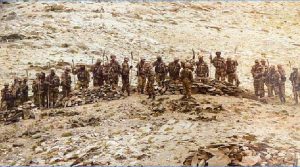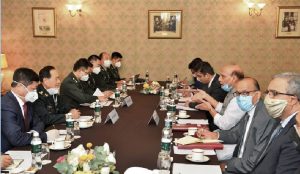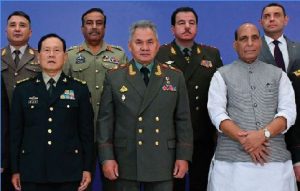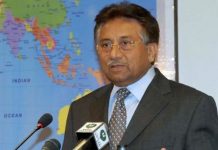 India’s firmness in paying back China in its own coin has renewed tensions along the Line of Actual Control in eastern Ladakh fuelling concerns of a limited military conflict.
India’s firmness in paying back China in its own coin has renewed tensions along the Line of Actual Control in eastern Ladakh fuelling concerns of a limited military conflict.
Though the India-China border stand-off has festered in eastern Ladakh for over four months, India’s recent strategic move of securing the southern banks of the Pangong Tso lake around the Chushul area, gaining strategic heights in Spangur Bowl and thwarting attempts by the Chinese People’s Liberation Army to violate the LAC, has unnerved the Asian dragon which may escalate the tension.
India’s strategic move, implemented August end, aimed to send a clear message to the Chinese that while India preferred the resolution of the border row through dialogue, it was ready to protect its territorial integrity.
For the Indian security forces, the move to gain strategic heights south of Pangong was in a way paying the PLA, which started the latest border face-off in May by violating the LAC, in the same coin.
Both the Indian security forces and the public at large had been very angry over the deadly clashes between the two armies in the Galwan Valley area on June 15 in which India lost 20 soldiers while trying to stop the PLA troops from violating the LAC. The incident reportedly took the lives of around 40 PLA troops though China is silent over the matter. The June 15 clashes created a huge trust deficit between the two nations and took the India-China relations to a new low.
There are no signs from China that it wants a course correction.
Instead, the dragon country continued to display aggression along the LAC while Beijing chose to provoke New Delhi further by saying it never recognized the Indian border state of Arunachal Pradesh and considered it to be part of the south Tibet area. The comment came as China denied knowledge of the abduction of five Arunachal Pradesh residents who were taken into custody by the PLA. The Indian Army had sought info about the five residents from PLA. India has in the past rubbished China’s claim on Arunachal.
Since May, India has blamed China for starting the border row by unilaterally trying to alter the LAC and later not showing any seriousness in resolving the matter peacefully. That appears to be true. There have been several rounds of talks between the diplomats and senior military commanders of the two countries to diffuse the border crisis but there has been no significant progress in the mutually-agreed disengagement along the de facto border.
 The high-level meeting between India’s Defence Minister Rajnath Singh and State Councillor and Defence Minister of China General Fenghe Wei on September 4 in Moscow on the sidelines of the Shanghai Cooperation Organisation conclave had generated hopes of a truce but the consultations failed to produce any positive outcome.
The high-level meeting between India’s Defence Minister Rajnath Singh and State Councillor and Defence Minister of China General Fenghe Wei on September 4 in Moscow on the sidelines of the Shanghai Cooperation Organisation conclave had generated hopes of a truce but the consultations failed to produce any positive outcome.
The two defence ministers listened to each other and agreed to keep talking in the future just as the two nations have been doing over the past four months.
The fact that China continued to deploy troops along the LAC has raised doubts over its intentions. India too has matched troop deployment in the area to counter the PLA. The seriousness of the situation could be gauged from the remark of Chief of Army Staff Gen Manoj Mukund Naravane who noted the LAC was tense after visiting the frontline troops and reviewing the troop deployment.
India’s Chief of Defence Staff Gen Bipin Rawat is monitoring the situation while Air Chief Marshal RKS Bhadauria has kept the Indian Air Force ready to meet any eventuality in the hilly terrain.
After the June 15 clashes, India’s external affairs minister Dr S Jaishankar spoke to his Chinese counterpart Wang Yi on June 17 and cautioned him to take corrective measures if China wanted the bilateral relations to grow.
As status quo prevailed, the two Special Representatives on the India-China border issue, India’s National Security Adviser Ajit Doval and Chinese Foreign minister Wang Yi, spoke to each other on July 5 following which a mutually-agreed disengagement process started in the Galwan Valley area but soon came to halt as the PLA refused to withdraw further.
A miffed India then did some tough talking and made it clear to the Chinese side that nothing short of a full disengagement along the LAC was acceptable.
Further talks between the senior military commanders of the two sides and consultations through the institutional arrangements like the Working Mechanism for Consultation and Coordination on India-China border issue through July-August failed to produce any results as the Chinese side remained stubborn in implementing the mutually-agreed disengagement.
The Russia visit of India’s defence minister Rajnath Singh to attend a key SCO meet came in the backdrop of renewed tensions on the de facto border.
Singh held a separate meeting with his Chinese counterpart Gen Fenghe Wei and bluntly told the Chinese side that India wanted a peaceful resolution to the Ladakh border but was committed to protecting its territorial integrity.
 Singh’s plain talking provoked China to make an angry remark that it would not give up even an inch of territory, indicating the PLA aggression along the LAC was a planned move and that the Chinese side was prepared for a long haul and even a limited military conflict.
Singh’s plain talking provoked China to make an angry remark that it would not give up even an inch of territory, indicating the PLA aggression along the LAC was a planned move and that the Chinese side was prepared for a long haul and even a limited military conflict.
In the light of what it does on the ground, China’s repeated reference to a peaceful resolution of the border dispute appears to be only an attempt to deflect attention of the world powers from its aggression in the Himalayas.
Responding to the meeting of the India and China defence ministers in Moscow, India’s external affairs ministry noted the two ministers had frank and in-depth discussions about the developments in the India-China border areas as well as on India-China relations.
Singh categorically conveyed India’s position on the developments along the Line of Actual Control including in the Galwan Valley in the Western Sector of the India-China Border Areas over the last few months.
He emphasised that the actions of the Chinese troops, including amassing of large number of troops, their aggressive behaviour and attempts to unilaterally alter the status quo were in violation of the bilateral agreements and not in keeping with the understandings reached between the Special Representatives of two sides, India’s National Security Adviser Ajit Doval and Chinese Foreign Minister Wang Yi on July 5, when they discussed the issue over phone for over two hours.
Singh stated clearly that while the Indian troops had always taken a very responsible approach towards border management, there should also be no doubt about India’s determination to protect its sovereignty and territorial integrity.
During the meeting, Gen Wei said that both sides should scrupulously implement the consensus reached between Indian Prime Minister Narendra Modi and Chinese President Xi Jinping and continue to solve the issues through dialogue and consultation, strictly follow the various bilateral agreements, strengthen the regulation of frontline troops and not undertake any provocative actions that might escalate the situation.
The two sides should focus on the overall situation of India-China relations and work together to de-escalate the situation as soon as possible, and maintain peace and tranquillity in the India-China border areas, Gen Wei said.
The Chinese Defence Minister suggested that both sides should maintain communication at all levels including between Singh and himself.
Singh pointed out that both sides should take guidance from the consensus of the leaders that maintenance of peace and tranquillity in the India-China border areas was essential for the further development of our bilateral relations and that two sides should not allow differences to become disputes. Accordingly, the two sides should resolve the ongoing situation and outstanding issues in the border areas peacefully through dialogue.
The Chinese Defence Minister conveyed that the Chinese side too desired to resolve the issues peacefully.
Singh advised that it was important therefore that Chinese side should work with the Indian side for complete disengagement at the earliest from all friction areas including Pangong Lake as well as de-escalation in border areas in accordance with the bilateral agreements and protocols on maintenance of peace and tranquillity in border areas, strictly respect and observe the line of actual control and should not make attempts to unilaterally change status quo.
He further said that the current situation should be handled responsibly and that neither side should take any further action that could either complicate the situation or escalate matters in the border areas.
Singh conveyed that the two sides should continue their discussions, including through diplomatic and military channels, to ensure complete disengagement and de-escalation and full restoration of peace and tranquillity along the LAC at the earliest. After Moscow, Rajnath Singh visited Tehran where he met his Irani counterpart Brigadier General Amir Hatami to discuss regional security and bilateral issues.
Renewed tension along the India-China border gave another chance to US President Donald J Trump to offer mediation, something which New Delhi had politely refused earlier.
India is concerned that the PLA has dug in its heels at the Finger 4 area along the Pangong Tso lake and in the Depsang Plains after initially implementing a pull-back at the Galwan Valley last month.
New Delhi fears the LAC transgression in eastern Ladakh is part of a bigger Chinese plan to grab India’s territory and alter the de facto border. Though there have been several transgressions by the PLA along the LAC over the past years, the present situation is even worse than 1962 when the two countries fought a war in the Galwan Valley area.
While being ready for a military conflict, India has been trying to counter China through economic measures like banning over 200 Chinese apps over charges of data security, barring Chinese companies from participating in infrastructure projects, changing FDI rules to curb Chinese investments and is even examining the validity of several Chinese educational institutes operating in India. India has also cancelled tenders of Chinese companies in around 44 new semi-high speed trains being planned by the national transporter.
But Chinese engagement with the Indian economy grew over the past decades and it may not be easy for the centre to snap the ties in one go.
The reality is that while Chinese apps have been banned, several mobile phone brands from that country continue to operate in India.
Rajnath Singh’s meeting with Gen Wei would not have happened without a nod from Prime Minister Narendra Modi who in an indirect message to China in his Independence Day speech said the Indian Army had always taught a lesson to anyone who tried to violate its territorial integrity either along the LAC or the LoC. The palpable tension on the border and the PM’s earlier remark that there was no intrusion have given room to the opposition Congress party to question the government’s China policy.
Congress leader Rahul Gandhi said on August 16: “Everybody believes in the capability and valour of the Indian army. Except the PM: Whose cowardice allowed China to take our land. Whose lies will ensure they keep it.”
Rahul said on August 14: “GOI is scared to face up to Chinese intentions in Ladakh. Evidence on the ground indicates that China is preparing and positioning itself. PM’s personal lack of courage and the media’s silence will result in India paying a huge price.”
Congress has also questioned contributions from several Chinese companies to the PMCARES fund the government has floated to deal with the Covid-19. A long-term China strategy will depend on India’s economic strength as well its defence preparedness. Faced with a border crisis the government has recently taken steps to shore up defence purchases but experts believe it should have done earlier. The Indian army is also prepared to deal with any misadventure from the Pakistani side, amid concerns over a two-front attack from the China-Pakistan combo to corner India. Pakistan’s shelling continues unabated along the Line of Control in Union Territory Jammu and Kashmir to disrupt peace in the area.
letters@tehelka.com











